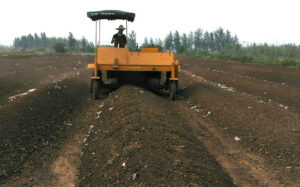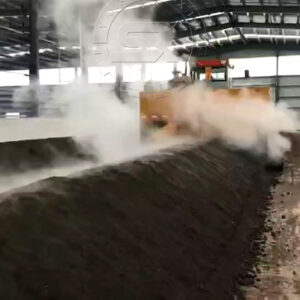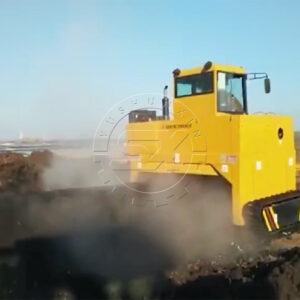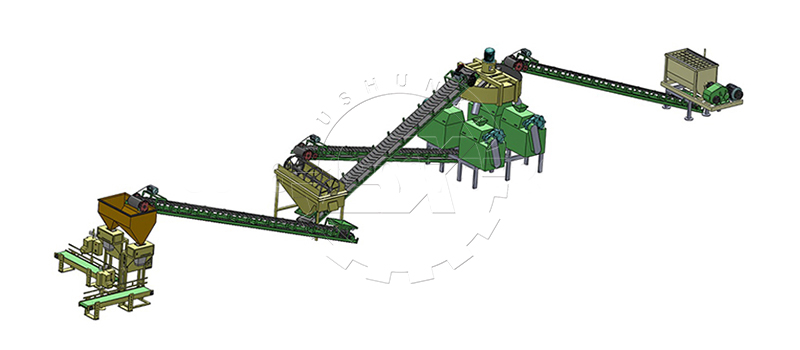Category: NPK fertilizer pelletizer
How to make small scale npk fertilizer
Creating NPK fertilizer on a small scale can be an enriching endeavor for home gardeners, small farms, or even start-up fertilizer producers. NPK stands for Nitrogen (N), Phosphorus (P), and Potassium (K), the three primary nutrients required for healthy plant growth. Here is a comprehensive guide on how to make small-scale NPK fertilizer.
Understanding NPK Ratios
Before diving into production, it’s crucial to comprehend the NPK ratio, which reflects the proportion of nitrogen, phosphorus, and potassium in the fertilizer. The specific needs of the plants being grown will dictate the ideal NPK ratio. A balanced 10-10-10 ratio is a common general-purpose fertilizer, but depending on the crop’s requirements, these ratios can vary.
Sourcing Raw Materials
Nitrogen Sources: For small-scale production, nitrogen can be sourced from blood meal, fish meal, or composted manure. Synthetic options include urea or ammonium sulfate.
Phosphorus Sources: Bone meal is a natural source of phosphorus. Alternatively, rock phosphate can be used if it is ground into a fine powder.
Potassium Sources: Wood ash is a natural source of potassium. Potassium sulfate or potassium chloride can also be used for a more concentrated source.
Equipment and Space
Basic Equipment
- Weighing scales for accurate measurement of ingredients
- Mixing tools such as a shovel or a mechanical mixer
- Protective gear like gloves and masks to prevent inhalation of dust
- Storage containers for both raw materials and the final product
Space Requirements
The space needed for small-scale production can be as simple as a well-ventilated shed or garage. Ensure the space is dry to prevent the fertilizer from clumping and that it is safe from contamination.
Production Process
Step 1: Measuring Ingredients
Using your weighing scales, measure out the raw materials according to the desired NPK ratio. Precision is essential here as it ensures the effectiveness of the final product.
Step 2: Grinding and Mixing
If the raw materials are not already in powdered form, they will need to be ground. Once powdered, mix the ingredients thoroughly to create a homogenous blend. A mechanical mixer can ensure a uniform mix, which is crucial for the fertilizer’s efficacy.
Step 3: Granulation (Optional)
For easier application, the mixed fertilizer can be granulated. Small-scale granulation can be done manually by creating small pellets and drying them, or with the use of a granulation machine. Compaction equipment is suitable for making small scale npk fertilizer.
Step 4: Curing and Drying
The mixture should be left to cure, which can take anywhere from several days to weeks. During this time, the chemical reactions between the components will occur. Following curing, the mixture should be completely dried to prevent mold or caking.
Step 5: Packaging and Storage
Once dry, the fertilizer can be packaged in airtight containers or bags. Label the packages with the NPK ratio and any instructions for use. Store the fertilizer in a cool, dry place until it’s ready to be used.
Safety Considerations
- Always wear protective gear to prevent skin irritation or inhalation of dust.
- Store raw materials and the final product safely to prevent contamination or accidental ingestion by children or pets.
- Ensure good ventilation when mixing and packaging the fertilizer.
Application Guidelines
To use the NPK fertilizer, follow the general rule of thumb of applying it every two to four months, depending on the crop’s needs. However, it’s essential to conduct soil tests to avoid over-fertilization, which can be harmful to plants and the environment.
Conclusion
Making small-scale NPK fertilizer can be a cost-effective and rewarding process, ensuring that the right balance of nutrients is available for plants. With careful planning, accurate measurements, and proper safety precautions, gardeners and small-scale farmers can produce their own high-quality fertilizer to foster bountiful growth and yields. And if you are interested in setting up a npk fertilizer plant, we can provude you with the best solution.
What machines can make npk fertilizer
NPK fertilizer, composed of essential nutrients nitrogen (N), phosphorus (P), and potassium (K), plays a crucial role in enhancing soil fertility and promoting healthy plant growth. The production of NPK fertilizer involves intricate processes, and machines have become indispensable in efficiently manufacturing this vital agricultural input.
1. Raw Material Processing
One key stage in NPK fertilizer production is the processing of raw materials. Machines are employed to handle the various components required for the fertilizer blend. Nitrogen-rich materials, such as urea, are processed alongside phosphorus sources like phosphate rock and potassium-containing minerals. These machines facilitate the grinding and mixing of raw materials to achieve the desired nutrient composition.
2. Granulation and Blending
Granulation is a pivotal step where machines are extensively utilized. Granulators are employed to convert the mixed raw materials into granules, ensuring a uniform distribution of nutrients. These machines play a critical role in determining the size and consistency of the final NPK fertilizer product. Additionally, blending machines are employed to homogenize the granules, ensuring a balanced nutrient content in every batch. We have many types of npk granulators for your choice. And the cost of npk granulator can also offer to you as a reference.
3. Coating and Finishing
To enhance the performance and appearance of NPK fertilizer, coating processes are employed. Machines are utilized to apply coatings that improve the fertilizer’s durability, reduce dust formation, and enable controlled nutrient release. These machines contribute to the overall quality and effectiveness of the final product. Finishing touches, such as cooling and screening, are also performed using specialized equipment.
4. Packaging Automation
In the final stages of NPK fertilizer production, machines take center stage in packaging. Automated packaging systems ensure efficiency, accuracy, and hygiene in the packaging process. These machines fill bags with the precisely measured amount of fertilizer, seal them, and prepare the final product for distribution. Automation not only enhances productivity but also minimizes the risk of errors in packaging.
5. Quality Control
Machines are integral to the quality control processes in NPK fertilizer production. Analytical instruments and sensors are employed to monitor the nutrient content, granule size, and overall quality of the final product. This ensures that the NPK fertilizer meets the required standards for agricultural use, providing farmers with a reliable and consistent product.
Conclusion: Advancements in Technology for NPK Fertilizer Production
The utilization of machines in NPK fertilizer production has evolved with advancements in technology. From raw material processing to packaging, automation and precision have become key aspects of efficient and high-quality fertilizer manufacturing. As agriculture continues to face the challenges of feeding a growing global population, the role of machines in NPK fertilizer production becomes increasingly significant in ensuring sustainable and productive farming practices. In addition, we can also provide you with bio npk fertilizer plant for sale.
How to Manufacture 19:19:19 NPK Fertilizer?
NPK fertilizer, also known as compound fertilizer, is a blend of three essential nutrients required for plant growth: nitrogen (N), phosphorus (P), and potassium (K). The ratio 19:19:19 signifies the percentage of each nutrient present in the fertilizer. This balanced formulation provides a well-rounded nutrient supply to plants, promoting healthy growth and optimal yield. Manufacturing 19:19:19 NPK fertilizer involves several steps, from sourcing raw materials to the final packaging. In this guide, we will outline the process, including key considerations and techniques.

compound fertilizer production line
- Raw Material Selection: The first step in manufacturing 19:19:19 NPK fertilizer is selecting high-quality raw materials. These materials typically include ammonium nitrate, urea, ammonium phosphate, and potassium chloride. It is essential to ensure the purity and quality of these components, as they directly affect the final composition and effectiveness of the fertilizer. Analyzing and testing the raw materials for impurities and nutrient content is crucial for maintaining consistency in production.
- Crushing and Grinding: Once the raw materials have been procured, they are subjected to crushing and grinding processes. This step aims to break down the materials into smaller particles, enhancing their solubility and improving nutrient availability. Specialized equipment, such as crushers and grinders, are used to achieve the desired particle size.
- Mixing and Blending: After crushing and grinding, the individual components are thoroughly mixed and blended together. The mixing process ensures uniform distribution of nutrients throughout the fertilizer. Various mixing techniques, such as paddle mixers or rotary drum mixers, are employed to achieve homogeneity.
- Granulation: Granulation is a critical step that transforms the blended fertilizer into granules. Granules are easier to handle, store, and apply, providing controlled release of nutrients. There are different granulation methods available, including drum granulation, pan granulation, and extrusion granulation. These techniques involve adding binders or water to the mixture to form granules of the desired size.

double roller granulation compound fertilizer making plant
- Drying: Following the granulation process, the newly formed granules are subjected to drying. Drying removes excess moisture and stabilizes the granules, preventing clumping and ensuring a longer shelf life. Dryers, such as rotary dryers or fluidized bed dryers, are commonly used for this purpose.
- Cooling: Once dried, the granules are cooled to ambient temperature. Cooling helps to solidify the granules and further enhance their stability. Cooling can be achieved through natural air cooling or specialized cooling machines.
- Screening and Sizing: After cooling, the granules undergo screening and sizing processes to remove any oversized or undersized particles. Proper sizing ensures a consistent product with uniform nutrient content. Vibrating screens or sieving machines are commonly employed for this purpose.
- Coating and Additives (Optional): In some cases, additional coatings or additives may be applied to the granules to improve their performance or enhance specific characteristics. These coatings can include polymer coatings, slow-release coatings, or micronutrient coatings. Such additions help to tailor the fertilizer to meet specific crop and soil requirements.
- Quality Control and Testing: Throughout the manufacturing process, quality control measures should be implemented to ensure the fertilizer meets the desired specifications. Regular testing for nutrient content, particle size distribution, moisture content, and other parameters is crucial to maintain consistency and effectiveness. Adjustments can be made during production based on the test results to achieve the desired NPK ratio.
- Packaging and Storage: The final step involves packaging the 19:19:19 NPK fertilizer in suitable containers, such as bags, sacks, or bulk packaging. Proper packaging ensures protection against moisture, contaminants, and physical damage. Additionally, labeling the packages with relevant information, including nutrient content, application instructions, and safety precautions, is essential.
Conclusion: Manufacturing 19:19:19 NPK fertilizer requires careful selection of raw materials, precise blending, granulation, drying, and quality control processes. Following these steps ensures the production of a high-quality fertilizer product that provides balanced nutrition to plants. It is important to adhere to safety standards, employ appropriate equipment, and regularly test the fertilizer to maintain its efficacy. With proper manufacturing techniques, 19:19:19 NPK fertilizer can contribute to improved crop yields and healthier plants, supporting sustainable agriculture practices.
How to make cow manure compost
Composting is a great way to turn organic waste into nutrient-rich soil. One common material used for composting is cow manure. Cow manure is a rich source of nitrogen, phosphorus, and potassium, making it an ideal ingredient for compost. In this article, we’ll discuss the steps involved in making cow manure compost.

cow dung compost
Step 1: Collecting the cow manure The first step in making cow manure compost is to collect the cow manure. You can collect it from a local farm or buy it from a garden center. Make sure that the cow manure is well-aged and has been stored for at least six months. Fresh cow manure is too strong and can burn plants, so it’s important to let it age before using it in compost.
Step 2: Preparing the compost pile The next step is to prepare the compost pile. You can use a compost turner or create a compost pile on the ground. If you’re using a compost turner, make sure it’s at least 3 feet wide, 3 feet deep, and 3 feet tall. This will ensure that there’s enough space for the cow manure to decompose properly.

cow dung compost
Step 3: Adding the cow manure Once the compost pile is ready, it’s time to add the cow manure. Spread a layer of cow manure on the bottom of the compost pile, making sure it’s evenly distributed. Then add a layer of dry leaves or straw on top of the cow manure. This will help balance the nitrogen-rich cow manure with carbon-rich material.
Step 4: Turning the compost pile After adding the cow manure and dry leaves, it’s time to turn the compost pile. This is an important step as it helps to mix the ingredients and ensure that the compost decomposes evenly. Use a cow dung compost turner to turn the compost pile every few weeks. Make sure to mix the outer layer with the inner layer to speed up the composting process.

windrow compost turner for cow dung compost
Step 5: Watering the compost pile Cow manure compost needs to be kept moist, but not too wet. Water the compost pile regularly to keep it moist. If the compost pile is too wet, it can become anaerobic, which can slow down the decomposition process. Aim for a moisture content of around 50%.
Step 6: Checking the temperature of the compost pile As the cow manure compost decomposes, it will generate heat. Check the temperature of the compost pile regularly using a compost thermometer. The ideal temperature for composting cow manure is between 120 and 150 degrees Fahrenheit. If the temperature is too low, the compost pile may not decompose properly. If the temperature is too high, it can kill the beneficial microorganisms that break down the compost.
Step 7: Harvesting the compost After several weeks or months, the cow manure compost will be ready to use. The compost will be dark brown and crumbly, with a rich earthy smell. Use a garden fork to harvest the compost from the bottom of the pile. Spread the compost over your garden beds or mix it with potting soil to enrich it with nutrients.
In conclusion, making cow manure compost is a simple process that requires a little patience and effort. By following these steps, you can turn cow manure into a nutrient-rich soil amendment that will benefit your plants and the environment.
Of course, you can check this page for more details about how to make cow manure compost!
Double Roller Extrusion Granulator for Compound Fertilizer Making
The Double Roller Extrusion Granulator for Compound Fertilizer Making is a necessary tool for NPK fertilizer’s efficient and successful production. This strong machine can produce compound fertilizer granules with uniform size and shape and high accuracy and consistency. The process of making granules using this granulator is simple and straightforward, allowing for larger batches to be produced fast and economically. This granulator is designed to handle a wide range of raw materials, enabling for the production of a wide range of compound fertilizer types. It can also process solid and liquid raw materials, making it incredibly versatile.
Features of Double Roller Extrusion Granulator for Compound Fertilizer Making
The Double Roller Extrusion Granulator for Compound Fertilizer Manufacturing is a game changer. It includes everything you might desire in a granulator and more. Here are a few of its amazing features:
- Its two rollers provide superior granulating performance, assuring smooth, constant grain size. You’ll be able to create the ideal compound fertilizer pellets every time.
- The roller extrusion granulator is very simple to operate and keep up. It is simple to use and requires little maintenance, thanks to its user-friendly design.
- The high-efficiency motor and gearbox of this roller press granulator let it function at lower noise levels, allowing you to work in peace and quiet.
Working Principle of a Double Roller Extrusion Granulator
The operation of a double roller extrusion granulator for compound fertilizer production is a complex but necessary process in the production of high-quality fertilizer. The granulator comprises two smooth, parallel rollers rotating at different speeds in opposite directions. The material is put into the machine, and the rollers compress and produce minute particles out of the substance. The combination of the two rollers enables a high rate of granulation even with tiny amounts of material, ensuring that the fertilizer produced is of optimal size, shape, and uniformity.
As the rollers rotate, the particles are extruded through small holes, creating a stream of granules that can be collected and packaged as fertilizer. Click here for details of roller press pellet making machine working principle.
Benefits of Using the Double Roller Extrusion Granulator
The double roller extrusion granulator delivers a wealth of benefits to those looking for efficient and effective production. From greater accuracy in granule production to lower energy consumption, this granulator is a must-have for anyone involved in the production process. Here are just a few of the advantages of using the double roller extrusion granulator:
- Greater Accuracy: With its two rollers moving in opposite directions, the double roller extrusion granulator can create more consistent and accurate granules that are uniform in size and shape. This ensures that you get the most out of every batch you produce.
- Faster Production Times: This machine can produce granules in a fraction of the time that manual production processes require, saving you time and money in the long run.
- Low Maintenance: This granulator requires minimal maintenance, so you won’t have to worry about continually checking on it to make sure it’s running correctly.
- Reduced Labor Costs: By eliminating the need for manual labor, you can reduce labor costs associated with the process of making compound fertilizer.
If you want to know more about double roller pelletizeror want to buy it for your fertilizer making business, you can visit https://fertilizerequipmentmanufacturer.com/double-roller-extrusion-granulator/









How to use rotary drum granulator to make npk fertilizer
April 16, 2024
Compound fertilizer making equipment, Compound fertilizer making line, compound fertilizer manufacturing, fertilizer equipment, Granulating Machine For Fertilizer, NPK fertilizer granulator, NPK fertilizer pelletizer
Comments Off on How to use rotary drum granulator to make npk fertilizer
cs
Rotary drum granulator is a versatile and efficient machine used in the production of NPK fertilizer. NPK stands for nitrogen, phosphorus, and potassium, which are essential nutrients for plant growth. This type of granulator is commonly used in large-scale fertilizer production plants due to its high output and ability to produce uniform and well-rounded granules. In this passage, we will discuss the steps on how to use a rotary drum granulator to make NPK fertilizer.
Preparation of Raw Materials
Before using the rotary drum granulator, it is essential to prepare the raw materials. The raw materials for NPK fertilizer production include urea, ammonium sulfate, monoammonium phosphate, diammonium phosphate, and potassium chloride. These materials should be crushed into fine powder and mixed in the right proportions to achieve the desired NPK ratio.
Feeding the Raw Materials
Once the raw materials are prepared, they should be fed into the rotary drum granulator. The granulator is equipped with a feeding system that allows for the continuous feeding of the raw materials. The feeding system should be adjusted to ensure that the materials are evenly distributed inside the granulator.
Granulation Process
The granulation process begins as the raw materials are mixed and tumbled inside the rotating drum granulator. The drum is lined with rubber or plastic to prevent the materials from sticking to the walls. As the materials are tumbled, they begin to form granules due to the rolling motion and the addition of a binder, such as water or a liquid fertilizer. And it can make 1-30 t/h npk fertilizer.
Drying and Cooling
After the granulation process, the granules are still wet and need to be dried. The rotary drum granulator is usually equipped with a drying system that uses hot air to remove the moisture from the granules. Once the granules are dry, they are cooled using a cooling system to prevent them from sticking together during storage and transportation.
Screening and Packaging
The final step in the production of NPK fertilizer is screening and packaging. The granules are passed through a screening machine to separate the oversized and undersized granules from the desired size. The oversized granules can be crushed and returned to the granulator, while the undersized granules can be used as a powder fertilizer. The final product is then bagged in bags or bulk containers for distribution.
In conclusion, using a rotary drum granulator to make NPK fertilizer is a straightforward process that involves the preparation of raw materials, feeding, granulation, drying, cooling, screening, and packaging. With the right equipment and proper operation, a rotary drum granulator can produce high-quality NPK fertilizer that can help improve crop yields and soil health.
large scale npk fertilizer makingrotary drum pelletizer